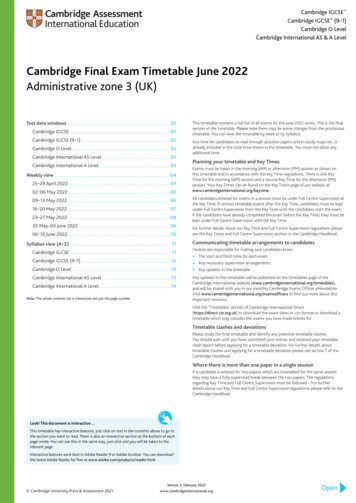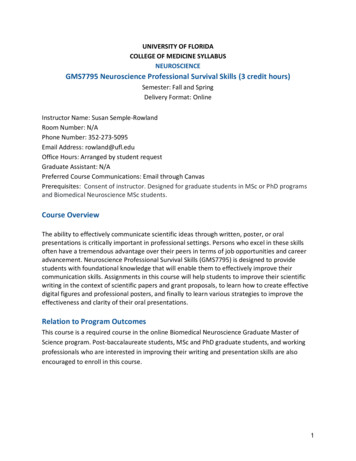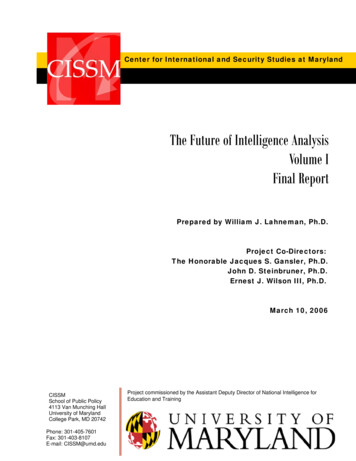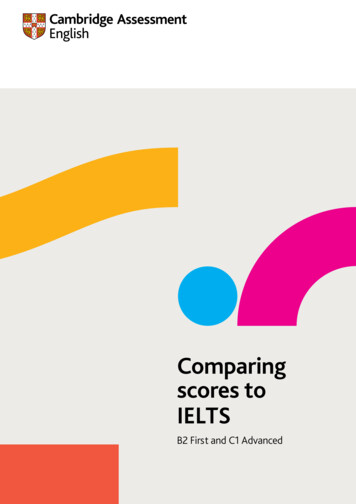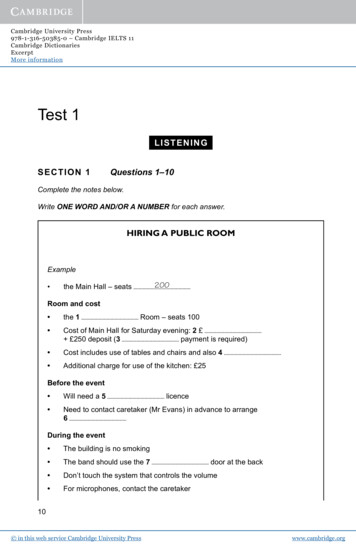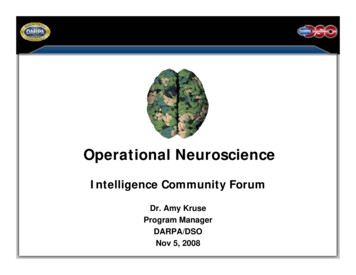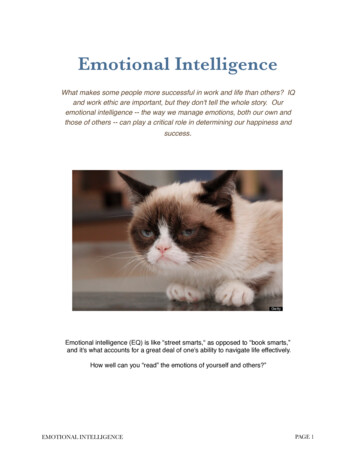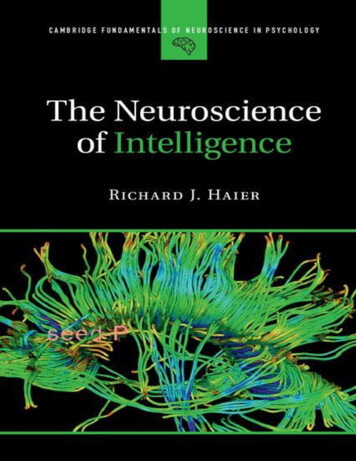
Transcription
THE NEURO SCIENCE O F INTELLIG ENCEThis book introduces new and provocative neuroscience research that advances ourunderstanding of intelligence and the brain. Compelling evidence shows that genetics playa more important role than environment as intelligence develops from childhood, and thatintelligence test scores correspond strongly to specific features of the brain assessed withneuroimaging. In understandable language, Richard J. Haier explains cutting-edgetechniques based on genetics, DNA, and imaging of brain connectivity and function. Hedispels common misconceptions – such as the belief that IQ tests are biased or meaningless– and debunks simple interventions alleged to increase intelligence. Readers will learnabout the real possibility of dramatically enhancing intelligence based on neurosciencefindings and the positive implications this could have for education and social policy. ngneuro-poverty,neuro-social–economic status, and the morality of enhancing intelligence for everyone. Onlineresources, including additional visuals, animations, questions and links, reinforce thematerial.Richard J. Haier earned his PhD from the Johns Hopkins University and is ProfessorEmeritus at the University of California, Irvine. He pioneered the use of neuroimaging tostudy intelligence in 1988 and has given invited lectures at meetings sponsored by theNational Science Foundation, the National Academy of Sciences, the Defense AdvancedResearch Projects Agency, the European Molecular Biology Organization, and Cold SpringHarbor Laboratory. In 2013, he created video lectures, The Intelligent Brain, for The GreatCourses. In 2016, he served as President of the International Society for IntelligenceResearch and became Editor-in-Chief of Intelligence.2
C A M B R I D G E FU N D A M E N TA L S O F N E U R O S C I E N C E I NP S YC H O L O G YDeveloped in response to a growing need to make neuroscience accessible to students andother non-specialist readers, the Cambridge Fundamentals of Neuroscience inPsychology series provides brief introductions to key areas of neuroscience researchacross major domains of psychology. Written by experts in cognitive, social, affective,developmental, clinical, and applied neuroscience, these books will serve as ideal primersfor students and other readers seeking an entry point to the challenging world ofneuroscience.Forthcoming Titles in the Series:The Neuroscience of Expertise, by Merim BilalićThe Neuroscience of Adolescence, by Adriana GalvánCognitive Neuroscience of Memory, by Scott D. SlotnickThe Neuroscience of Aging, by Angela GutchessThe Neuroscience of Addiction, by Francesca Filbey3
T HE N E U R OSC I E N C E OFI N T E L L I GE N C ERichard J. HaierUniversity of California, Irvine4
32 Avenue of the Americas, New York, NY 10013Cambridge University Press is part of the University of Cambridge.It furthers the University’s mission by disseminating knowledge in the pursuit ofeducation, learning, and research at the highest international levels of excellence.www.cambridge.orgInformation on this title: www.cambridge.org/9781107089778 Richard J. Haier 2017This publication is in copyright. Subject to statutory exception and to the provisions of relevantcollective licensing agreements, no reproduction of any part may take place without the writtenpermission of Cambridge University Press.First published 2017Printed in the United States of America by Sheridan Books, Inc.A catalogue record for this publication is available from the British Library.Library of Congress Cataloguing in Publication DataNames: Haier, Richard J.Title: The neuroscience of intelligence / Richard J. Haier,University of California, Irvine.Description: New York, NY : Cambridge University Press, 2017. Series: Cambridge fundamentals of neuroscience in psychology Includes bibliographical references and index.Identifiers: LCCN 2016026754 ISBN 9781107089778 (hardback) 5
ISBN 9781107461437 (paperback)Subjects: LCSH: Consciousness. Neurosciences.Classification: LCC QP411 .H35 2017 DDC 612.8/2339–dc23LC record available at https://lccn.loc.gov/2016026754ISBN 978-1-107-08977-8 HardbackISBN 978-1-107-46143-7 PaperbackAdditional resources for this publication are y/cognition/neuroscience-intelligenceCambridge University Press has no responsibility for the persistence or accuracy of URLs forexternal or third-party Internet websites referred to in this publication and does not guaranteethat any content on such websites is, or will remain, accurate or appropriate.6
To my family, who changed the orbit of my life, andTo the memory of my father, who died too young, andTo the memory of my mother, who carried on, andTo the memory of my grandparents, who sacrificed for a future they could scarcelyimagine.7
Advanced Praise“Forty years of Haier’s research and thinking about the neuroscience of intelligence have beencondensed into this captivating book. He consistently gets it right, even with tricky issues likegenetics. It is an intelligent and honest book.”Robert Plomin, Institute of Psychiatry, Professor of Psychology and Neuroscience, King’sCollege London“An original, thought-provoking review of modern research on human intelligence from one ofits pioneers.”Aron K. Barbey, Director, Decision Neuroscience Laboratory, Associate Professor inPsychology, Neuroscience, and Bioengineering, Beckman Institute for Advanced Scienceand Technology, University of Illinois at Urbana-Champaign“Deftly presenting the latest insights from genetics and neuroimaging, Haier provides a brilliantexposition of the recent scientific insights into the biology of intelligence. Highly timely, clearlywritten, certainly a must-read for anyone interested in the neuroscience of intelligence!”Danielle Posthuma, Professor of Complex Trait Genetics, VU University Amsterdam, TheNetherlands“The trek through the maze of recent work using the modern tools of neuroscience andmolecular genetics will whet the appetite of aspiring young researchers. The author’s enthusiasmfor the discoveries that lie ahead is infectious. Kudos!”Thomas J. Bouchard, Jr., Emeritus Professor of Psychology, University of Minnesota“Richard Haier invites us to a compelling journey across a century of highs and lows ofintelligence research, settling old debates and fueling interesting questions for new generations tosolve. From cognitive enhancement to models predicting IQ based on brain scans, the quest todefine the neurobiological basis of human intelligence has never been more exciting.”Emiliano Santarnecchi, Berenson-Allen Center for Noninvasive Brain Stimulation,Harvard Medical School8
“Loud voices have dismissed and derided the measurement of human intelligence differences,their partial origins in genetics, and their associations with brain structure and function. If theyrespect data, Haier’s book will quieten them. It’s interesting to think how slim a book with thetitle ‘The Neuroscience of Intelligence’ would have been not long ago, and how big it will besoon; Haier’s lively book is a fingerpost showing the directions in which this important area isheading.”Ian J. Deary, Professor of Differential Psychology, University of Edinburgh“The biology of few psychological differences is as well understood as that of intelligence.Richard Haier pioneered the field of intelligence neuroscience and he is still at its forefront. Thisbook summarizes the impressive state the field has reached, and foreshadows what it mightbecome.”Lars Penke, Professor of Biological Personality Psychology, Georg August UniversityGöttingen“It increasingly appears that we are within years, not decades, of understanding intelligence at amolecular level – a scientific advance that will change the world. Richard Haier’s TheNeuroscience of Intelligence gives us an overview of the state of knowledge that covers not onlyhis own field, the brain, but also recent developments in genetics, and he does so engagingly andaccessibly for the non-specialist. I highly recommend it.”Charles Murray, WH Brady Scholar, American Enterprise Institute“This book was overdue: a highly readable and inspiring account of cutting-edge research inneuroscience of human intelligence. Penned by Richard Haier, the eminent founder of thisresearch field, the book is an excellent introduction for beginners and a valuable source ofinformation for experts.”Dr. Aljoscha Neubauer, University of Graz, Austria, & past president of the InternationalSociety for the Study of Individual Differences“This book is ‘A Personal Voyage through the Neuroscience of Intelligence’. Reading thiswonderful volume ‘forces thinking,’ which can be said only about a very small fraction ofbooks. Here the reader will find reasoned confidence on the exciting advances, waiting nextdoor, regarding the neuroscience of intelligence and based on the author’s three basic laws: 1) no9
story about the brain is simple, 2) no one study is definitive, and 3) it takes many studies andmany years to sort things out.”Roberto Colom, Professor of Differential Psychology, Universidad Autonoma de Madrid“Richard Haier’s The Neuroscience of Intelligence is an excellent summary of the majorprogress made in the fields of psychology, genetics and cognitive neuroscience, expanding uponthe groundbreaking work of The Bell Curve. He addresses the many misconceptions and mythsthat surround this important human capacity with a clear summary of the vast body of researchnow extending into the human brain and genome.”Rex E. Jung, Department of Neurosurgery, University of New Mexico10
ContentsPrefaceAcknowledgments1 What We Know About Intelligence From the Weight of StudiesLearning ObjectivesIntroduction1.1 What is Intelligence? Do You Know It When You See It?1.2 Defining Intelligence for Empirical Research1.3 The Structure of Mental Abilities and the g-Factor1.4 Alternative Models1.5 Focus on the g-Factor1.6 Measuring Intelligence and IQ1.7 Some Other Intelligence Tests1.8 Myth: Intelligence Tests are Biased or Meaningless1.9 The Key Problem for “Measuring” Intelligence1.10 Four Kinds of Predictive Validity for Intelligence Tests1.11 Why Do Myths About Intelligence Definitions and Measurement Persist?Chapter 1 SummaryReview QuestionsFurther Reading2 Nature More than Nurture: The Impact of Genetics on IntelligenceLearning ObjectivesIntroduction2.1 The Evolving View of Genetics2.2 Early Failures to Boost IQ2.3 “Fraud” Fails to Stop Genetic Progress11
2.4 Quantitative Genetic Findings also Support a Role for EnvironmentalFactors2.5 Molecular Genetics and the Hunt for Intelligence Genes2.6 Seven Recent Noteworthy Studies of Molecular Genetic ProgressChapter 2 SummaryReview QuestionsFurther Reading3 Peeking Inside the Living Brain: Neuroimaging Is a Game-changer forIntelligence ResearchLearning ObjectivesIntroduction3.1 The First PET Studies3.2 Brain Efficiency3.3 Not All Brains Work in the Same Way3.4 What the Early PET Studies Revealed and What They Did Not3.5 The First MRI Studies3.6 Basic Structural MRI Findings3.7 Improved MRI Analyses Yield Consistent and Inconsistent Results3.8 Imaging White Matter Tracts with Two Methods3.9 Functional MRI (fMRI)3.10 The Parieto-frontal Integration Theory (PFIT)3.11 Einstein’s BrainChapter 3 SummaryReview QuestionsFurther Reading4 50 Shades of Gray Matter: A Brain Image of Intelligence is Worth a ThousandWordsLearning ObjectivesIntroduction4.1 Brain Networks and Intelligence12
4.2 Functional Brain Efficiency – is Seeing Believing?4.3 Predicting IQ From Brain Images4.4 Are “Intelligence” and “Reasoning” Synonyms?4.5 Common Genes for Brain Structure and Intelligence4.6 Brain Imaging and Molecular GeneticsChapter 4 SummaryReview QuestionsFurther Reading5 The Holy Grail: Can Neuroscience Boost Intelligence?Learning ObjectivesIntroduction5.1 Case 1: Mozart and the Brain5.2 Case 2: You Must Remember This, and This, and This 5.3 Case 3: Can Computer Games for Children Raise IQ?5.4 Where are the IQ Pills?5.5 Magnetic Fields, Electric Shocks, and Cold Lasers Target Brain Processes5.6 The Missing Weight of Evidence for EnhancementChapter 5 SummaryReview QuestionsFurther Reading6 As Neuroscience Advances, What’s Next for Intelligence Research?Learning ObjectivesIntroduction6.1 From Psychometric Testing to Chronometric Testing6.2 Cognitive Neuroscience of Memory and Super-Memory6.3 Bridging Human and Animal Research with New Tools Neuron by Neuron6.4 Bridging Human and Machine Intelligence Circuit by Circuit6.5 Consciousness and Creativity6.6 Neuro-poverty and Neuro-Social–Economic Status (SES): Implications forPublic Policy Based on the Neuroscience of Intelligence13
6.7 Final ThoughtsChapter 6 SummaryFurther ReadingGlossaryReferencesIndex14
PrefaceWhy are some people smarter than others? This book is about what neuroscience tells usabout intelligence and the brain. Everyone has a notion about defining intelligence and anopinion about how differences among individuals may contribute to academic success andlife achievement. Conflicting and controversial ideas are common about how intelligencedevelops. You may be surprised to learn that the scientific findings about all these topicsare more definitive than you think. The weight of evidence from neuroscience research israpidly correcting outdated and erroneous beliefs.I wrote this book for students of psychology and neuroscience, educators, publicpolicy makers, and for anyone else interested in why intelligence matters. On one hand, thisaccount is an introduction to the field that presupposes no special background; on the otherhand, it is more in-depth than popularized accounts in the mass/social media. My emphasisis on explaining the science of intelligence in understandable language. The viewpoint thatsuffuses every chapter is that intelligence is 100% a biological phenomenon, genetic or not,influenced by environment or not, and that the relevant biology takes place in the brain.That is why there is a neuroscience of intelligence to write about.This book is not neutral, but I believe it is fair. My writing is based on over 40 yearsof experience doing research on intelligence using mental ability testing and neuroimagingtechnology. My judgments about the research to include are based on the existing weight ofevidence. If the weight of evidence changes for any of the topics covered, I will change mymind, and so should you. No doubt, the way I judge the weight of evidence will not pleaseeveryone, but that is exactly why a book like this elicits conversation, potentially opensminds, and with luck, fosters a new insight or two.Be advised, if you already believe that intelligence is due all or mostly to theenvironment, new neuroscience facts might be difficult to accept. Denial is a common15
response when new information conflicts with prior beliefs. The older you are, the moreimpervious your beliefs may be. Santiago Ramon Cajal (1852–1934), the father ofneuroscience, once wrote, “Nothing inspires more reverence and awe in me than an oldman who knows how to change his mind” (Cajal, 1924). Students have no excuse.The challenge of neuroscience is to identify the brain processes necessary forintelligence and discover how they develop. Why is this important? The ultimate purposeof all intelligence research is to enhance intelligence. Finding ways to maximize a person’suse of their intelligence is one goal of education. It is not yet clear from the weight ofevidence how neuroscience can help teachers or parents do this. Finding ways to increaseintelligence by manipulating brain mechanisms is quite another matter and one whereneuroscience has considerable potential. Surely, most people would agree that increasingintelligence is a positive goal for helping people in the lower-than-normal range who oftencannot learn basic self-care routines or employment skills. What then is the argumentagainst enhancing intelligence so students can learn more, or adults can enjoy increasedprobability of greater achievement? If you have a negative reaction to this bold statement ofpurpose, my hope is that by the end of this book you reconsider.Three laws govern this book: (1) no story about the brain is simple; (2) no one studyis definitive; (3) it takes many years to sort out conflicting and inconsistent findings andestablish a compelling weight of evidence. With these in mind, Chapter 1 aims to correctpopular misinformation and summarizes how intelligence is defined and measured forscientific research. Some of the validity data will surprise you. For example, childhood IQscores predict adult mortality. Chapter 2 reviews the overwhelming evidence that there aremajor genetic effects on intelligence and its development. Conclusive studies fromquantitative and molecular genetics leave no doubt about this. Because genes always workthrough biological mechanisms, there must be a neurobiological basis for intelligence, evenwhen there are environmental influences on those mechanisms. Genes do not work in avacuum; they are expressed and function in an environment. This interaction is a theme of“epigenetics” and we will discuss its role in intelligence research.Chapters 3 and 4 delve into neuroimaging and how these revolutionary technologiesvisualize intelligence in the brain, and indicate the neurobiological mechanisms involved.16
New twin studies of intelligence, for example, combine neuroimaging and DNA analyses.Key results show common genes for brain structure and intelligence. Chapter 5 focuses onenhancement. It begins with critiques of three widely publicized but incorrect claims aboutincreasing IQ and ends with electrical brain stimulation. So far, there is no proven way toenhance intelligence, but I explain why there is a strong possibility that manipulation ofsome genes and their biological processes may achieve dramatic increases. Imagine amoonshot-like national research effort to reach this goal; guess which nation apparently ismaking this commitment (it is not the USA).Chapter 6 introduces several astonishing neuroscience methods for studying synapses,neurons, circuits, and networks that move intelligence research even deeper into the brain.Soon we might measure intelligence based on brain speed, and build intelligent machinesbased on how the brain actually works. Large collaborative efforts around the world arehunting intelligence genes, creating virtual brains, and mapping brain fingerprints unique toindividuals – fingerprints that predict intelligence. Overlapping neuro-circuits forintelligence, consciousness, and creativity are explored. Finally, I introduce the terms“neuro-poverty” and “neuro-SES” (social–economic status) and explain why neuroscienceadvances in intelligence research may inform education policies.Personally, I believe we are entering a Golden Age of intelligence research that goesfar beyond nearly extinct controversies about whether intelligence can be defined ormeasured and whether genes are involved. My enthusiasm about this field is intended topermeate every chapter. If you are an educator, policy maker, parent, or student you need toknow what twenty-first century neuroscience says about intelligence. If any of you aredrawn to a career in psychology or neuroscience and pursue the challenges of intelligenceresearch, then that is quite a bonus.17
AcknowledgmentsBecause my academic appointments have been in medical schools, I have never hadpsychology graduate students working with me on research, so I have none to thank. I havehad fabulous collaborators over the years and they have made all the difference. Most ofmy neuroimaging studies of intelligence are co-authored by friends Rex Jung, RobertoColom, Kevin Head, Sherif Karama, and Michael Alkire. Many others, too numerous toname, contributed time, effort, and ideas over the last 40 years. I am indebted to all ofthem. I am especially grateful to Matthew Bennett at Cambridge University Press forinviting me to contribute to their Neuroscience series. It is the first time intelligence hasbeen included. Drafts of this book were read all or in part by Rosalind Arden, RobertoColom, Doug Detterman, George Goodfellow, Earl Hunt, Rex Jung, Sherif Karama, MartyNemko, Aljoscha Neubauer, Yulia Kovas, and Lars Penke. Their corrections and insightswere invaluable; any remaining errors are mine. Although I have included a substantialnumber of citations to relevant work, I could not possibility include everything I wouldhave liked to. In fact, the field is moving so quickly, I added newly published papers rightup to the last days before my deadline. I apologize to anyone who feels his or her workwas left out. Some topics, explanations, and illustrations in this book were included in aset of my video lectures, The Intelligence Brain ( 2013 The Teaching Company, LLC:www.thegreatcourses.com). Most of all, my wife protected my work time against allintrusions and that is why this book exists.18
Chapter OneWhat We Know About Intelligence From theWeight of Studies the attack on tests is, to a very considerable and very frightening degree, an attack ontruth itself by those who deal with unpleasant and unflattering truths by denying them andby attacking and trying to destroy the evidence for them.(Lerner, 1980, page 11)Intelligence is surely not the only important ability, but without a fair share of intelligence,other abilities and talents usually cannot be fully developed and effectively used It[intelligence] has been referred to as the “integrative capacity” of the mind.(Jensen, 1981, page 11)The good thing about science is that it’s true whether or not you believe in it.(Neil deGrasse Tyson, HBO’s Real Time with Bill Maher, April 2, 2011)Learning ObjectivesHow is intelligence defined for most scientific research?How does the structure of mental abilities relate to the concept of a generalintelligence factor?Why do intelligence test scores estimate but not measure intelligence?19
What are four kinds of evidence that intelligence test scores have predictive value?Why do myths about intelligence persist?IntroductionWhen a computer beats a human champion at chess or a verbal knowledge game likeJeopardy, is the computer smarter than the person? Why can some people memorizeexceptionally long strings of random numbers or tell the day of the week on any date in thepast, present, or future? What is artistic genius and is it related to intelligence? These aresome of the challenges to defining intelligence for research. It is obvious that no matterhow you define intelligence, it must have something to do with the brain. Among the manymyths about intelligence, perhaps the most pernicious is that intelligence is a concept tooamorphous and ill-defined for scientific study. In fact, the definitions and measures used forresearch are sufficiently developed for empirical investigations and have been so for over100 years. This long research tradition used various kinds of mental ability tests andsophisticated statistical methods known collectively as psychometrics. The new science ofintelligence builds on that database and melds it with new technologies of the last twodecades or so, especially genetic and neuroimaging methods. These advances, the mainfocus of this book, are helping evolve a more neuroscience-oriented approach tointelligence research. The trajectory of this research is similar to that in other scientificfields, which has led from better measurement tools to more sophisticated definitions andunderstandings of, for example, an “atom” and a “gene”. Before we address the brain insubsequent chapters, this chapter reviews the current state of basic intelligence researchissues regarding the definition of intelligence as a general mental ability, the measurementof intelligence relative to other people, and the validity of intelligence test scores forpredicting real-world variables.1.1 What is Intelligence? Do You Know It When You20
See It?It may seem odd, but let’s start our discussion of intelligence with the value of pi, thecircumference of a circle divided by its diameter. As you know, the value of pi is alwaysthe same: 3.14 carried out to an infinite, non-repeating sequence of decimals. For ourpurpose here, it’s just a very long string of numbers in seemingly random order that isalways the same. This string of numbers has been used as a simple test of memory. Somepeople can memorize a longer string of the pi sequence than others. And, a few people canmemorize a very long string.Daniel Tammet, a young British man, studied a computer printout of the pi sequencefor a month. Then, for a demonstration organized by the BBC, Daniel repeated the sequencefrom memory publically while checkers with the computer printout followed along. Danielstopped over 5 hours later after correctly repeating 22,514 digits in the sequence. Hestopped because he was tired and feared making a mistake (Tammet, 2007).In addition to his ability to memorize long strings of numbers, Daniel also has afacility to learn difficult languages. The BBC also arranged a demonstration of his languageability when they moved him to Iceland to learn the local language with a tutor. Two weekslater he conversed on Icelandic TV in the native tongue. Do these abilities indicate thatDaniel is a genius or, at least, more intelligent than people who do not have these mentalabilities?Daniel has a diagnosis of autism and he may have a brain condition calledsynesthesia. Synesthesia is a mysterious disorder of sensory perception where numbers, forexample, may be perceived as colors, shapes, or even odors. Something about brain wiringseems to be amiss, but it is so rare a condition that research is quite limited. In Daniel’scase, he reports that he sees each digit as a different color and shape and when he recallsthe pi sequence, he sees a changing “landscape” of colors and shapes rather than numericaldigits. Daniel is also atypical among people with autism because he has a higher thanaverage IQ.Recalling 22,514 digits of pi from memory is a fascinating achievement no matter howit is accomplished (the record is an astonishing 67,890 digits – see Section 6.2). So is21
learning to converse in the Icelandic language in two weeks. There are people withextraordinary, specific mental abilities. The term “savant” typically is used to describethese rare individuals. Sometimes the savant ability is an astonishing memory or the abilityto calculate rapidly large numbers mentally, or the ability to play any piece of music afteronly hearing it once, or the ability to create artistic drawings or sculptures.Kim Peek, for example, was able to remember an extraordinary range of facts andfigures. He read thousands of books, especially almanacs, and he read each one by quicklyscanning page after page. He could then recall this information at will as he demonstratedmany times in public forums in response to audience questions: Who was the 10th king ofEngland? When and where was he born? Who were his wives? And so on. Kim’s IQ wasquite low and he could not care for himself. His father managed all aspects of his lifeexcept when he answered questions from memory.Steven Wilshire has different savant ability. Steven draws accurate, detailed picturesof city skylines and he does so from memory after a short helicopter tour of the city. Heeven gets the number of windows in buildings correct. You can buy one of his many cityskyline drawings at a gallery in London or online. Alonso Clemons is a sculptor. He alsohas a low IQ. His mother claims he was dropped on his head as a baby. Alonso createsanimal sculptures in precise detail, typically after only a brief look at his subject. Theartistry is amazing. Derek Pavacinni has a low IQ and cannot care for himself. He is blindfrom birth. Derek is a virtuoso piano player. He amazes audiences by playing any piece ofmusic after hearing it only once, and he can play it in any musical style. It is worth notingthat Albert Einstein and Isaac Newton did not have any of these memory, drawing,sculpting, or musical abilities.Savants raise two obvious questions: How do they do it, and why can’t I? We don’treally know the answer to either question. These individuals also raise a core questionabout the definition of intelligence. They are important examples of the existence ofspecific mental abilities. But is extraordinary specific mental ability evidence ofintelligence? Most savants are not intelligent. In fact, savants typically have low IQ andoften cannot care for themselves. Clearly extraordinary but narrow mental ability is notwhat we usually mean by intelligence.22
One more example is Watson, the IBM computer that beat two all-time Jeopardychampions. Jeopardy is a game where answers are provided and players must deduce thequestion. The rules were that Watson could not search the web. All information had to bestored inside Watson’s 15 petabytes of memory, which was about the size of 10refrigerators. Here’s an example: In the Category, “Chicks Dig Me,” the answer is: Thismystery writer and her archeologist husband dug to find the lost Syrian city of Arkash.This sentence is actually quite complex for a computer to understand, let alone formulatethe answer in the form of a question. In case you’re still thinking, the answer, in the form ofa question is: Who was Agatha Christie? Watson answered this faster than the humans, andin the actual match, Watson trounced the two human champions. Does Watson have thesame kind of intelligence as humans, or better? Let’s look at some definitions to consider ifWatson is more like a savant or Albert Einstein.1.2 Defining Intelligence for Empirical ResearchNo matter how you define intelligence, you know someone who is not as smart as you are.It would be unusual if you have never called someone an “idiot” or a “moron” or just plaindumb, and meant it literall
THE NEUROSCIENCE OF INTELLIGENCE This book introduces new and provocative neuroscience research that

